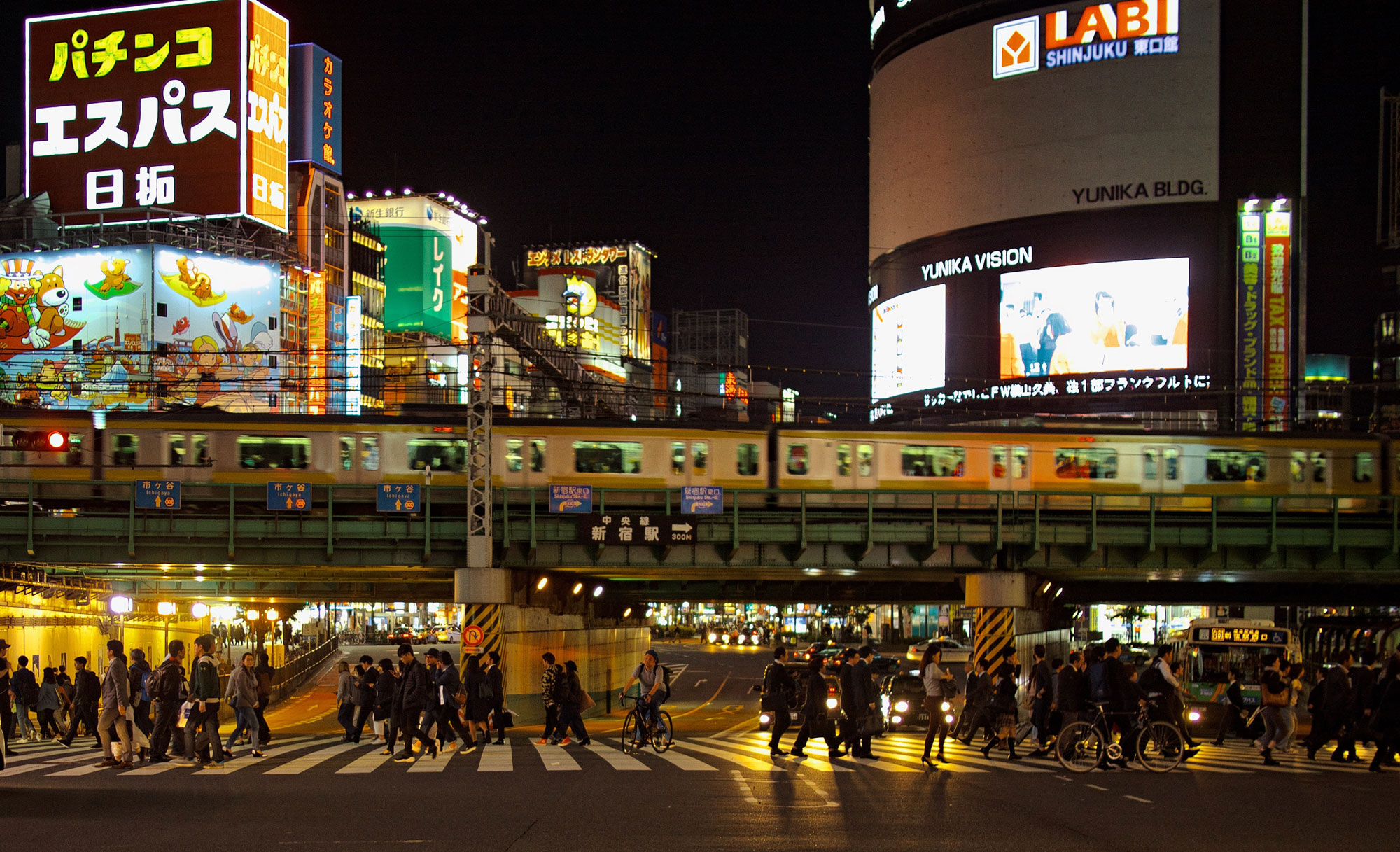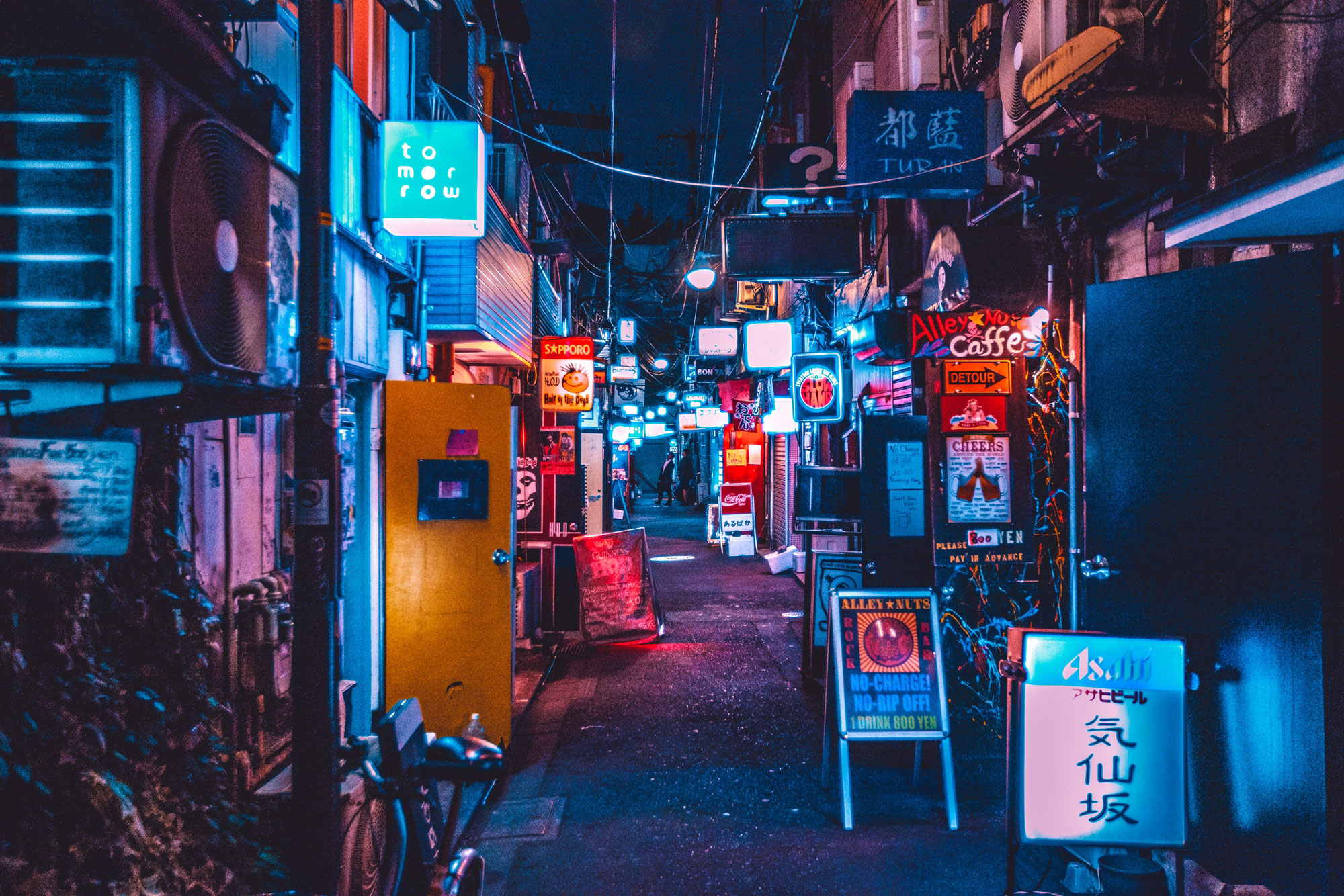Japan Travel: Shinjuku
Shinjuku

Photo credits: Sergio Rola
Shinjuku (新宿), importante centro commerciale ed amministrativo e sede del nodo ferroviario più trafficato al mondo, fa parte dei 23 quartieri speciali di Tokyo.
Non solo treni, Shinjuku è anche una delle maggiori tappe degli autobus a lunga percorrenza; il Busta Shinjuku, un grande terminal, è situato proprio in cima alla stazione ferroviaria.
Prendendo come riferimento la stazione, ad ovest di essa ci si ritrova nello Skyscraper District. Qui sorgono gli edifici più alti di Tokyo tra i quali hotel di lusso e le torri gemelle del Palazzo del Governo Metropolitano di Tokyo. Progettato dal famoso architetto Kenzō Tange, qui è dove viene gestita l’amministrazione politica e pubblica della città. Le sue torri sono alte 243 metri e i ponti di osservazione, situati al 45° piano, sono aperti al pubblico gratuitamente.
Proprio da quei ponti di osservazione ciò che si può notare è la Mode Gakuen Cocoon Tower, un grattacielo situato nel quartiere finanziario di Nishi-Shinjuku. Alto 203 metri, è costituito da 50 piani al cui interno trovano spazio tre scuole: una di moda (la Tokyo Mode Gakuen), una di design (la HAL Tokyo and Shuto Ikou) e una di medicina. L’architettura, anch’essa progettata da Tange, dona al grattacielo una forma a bozzolo creata dalla forma spanciata dei tubi in alluminio bianchi (curtain wall) attorcigliati che salgono in diagonale.

Photo credits: Google immagini
Shinjuku non è solo modernità, ma è anche la sede di uno dei più grandi e più piacevoli parchi di Tokyo: Shinjuku Gyoen, dove la vista dei ciliegi in fiore è rinomata per essere tra le migliori del paese. Il parco è stato aperto al pubblico nel 1949 dopo essere stato il giardino della famiglia Imperiale dal 1903.
I quartieri del distretto

Photo credits: Gor Badoyan
Tra i più famosi e discussi, ecco Kabukichou, situato a nord-est della stazione. Esso è il più grande quartiere a luci rosse del Giappone, e forse è proprio per questo che ad annunciarne l’ingresso c’è una grandissima insegna luminosa rossa. La storia di questo quartiere è davvero curiosa: il suo nome proviene da un teatro kabuki che non fu mai costruito. Dal 1872, quinto anno dell’Era Meiji, quando in Giappone furono revocate le leggi che regolavano i rapporti con le geishe e le prostitute, Kabukichou divenne il principale quartiere a luci rosse della città di Tokyo. Successivamente le leggi contro la prostituzione divennero più ferree e dopo la seconda guerra mondiale il quartiere fu sottoposto ad alcuni tentativi atti a cambiare la sua immagine. Fu quindi fatto il tentativo di trasferire qui il teatro Kabuki-za di Ginza, distrutto da un incendio, ma alla fine il teatro fu ricostruito a Ginza, mentre a Kabukicho rimase solo il nome.
Un altro teatro fu comunque costruito a Kabukichou, il teatro Koma, che si trova in un edificio che contiene alcuni bar e discoteche.

Photo credits: Benjamin Hung
A Kabukichou comunque non si dorme mai e questa zona vanta numerosi ristoranti, bar, discoteche, “hotel dell’amore” e una varietà di strutture a luci rosse per tutti i sessi e gli orientamenti. Camminare per Kabukichou può essere rischioso in fatto di spese. I costi sono esorbitanti poichè tutto è gestito esclusivamente dalla Yakuza, uno dei motivi per cui Kabukicho è anche uno dei quartieri più sicuri di Tokyo in quanto c’è un attento controllo nelle varie attività. Proprio qui, in un dedalo di stradine ci si imbatte nel Golden Gai (la via dorata) in cui una serie di piccolissimi bar molto particolari fanno capolino. I posti a sedere al loro interno sono pochi, dai 2 ai 5, e spesso sono situati anche negli scantinati! Destreggiandosi tra di essi, si possono udire risate fragorose e spiando all’interno intravedere personaggi eccentrici, scrittori, registi e qualche turista curioso. I piccoli locali possono essere anche a tema, ma in ognuno di essi ciò che si può sempre bere è lo yamazaki, un particolare whisky giapponese.
Svincolandosi dal Golden Gai, troviamo Ichigaya, sede del Ministero della Difesa. Okubo, ricca di negozi di gestione coreana che vendono cibo tradizionale e gadget classici della cultura pop coreana. Inoltre vi si trovano bar a tema coreani, club a luci rosse e ristoranti. Shinjuku ni-chome, il quartiere gay di Tokyo e infine Takadanobaba. Quest’ultima, è una zona prevalentemente frequentata dagli studenti delle vicine Università di Waseda e Università Gakushuin. Qui sono presenti scuole di preparazione e intrattenimento, molti bar e Izakaya. L’Izakaya, composto dalle parole “i” (sedersi), saka (sake) e ya (negozio), è un tipico locale giapponese che vende bevande accompagnate da cibo, una sorta di pub.
Il simbolo di Takadanobaba è il “Big Box”, un grande edificio a forma di scatola, a fianco della stazione.

Photo credits: Google immagini
Sacro e profano

Photo credits: Node Reaver’s Blog
Sembra incredibile, eppure è proprio tra i grattacieli di Shinjuku che si apre uno spazio di pace e preghiera: il Tempio shintoista Hanazono. Fu fondato nel 1600 ed è una delle mete degli uomini d’affari in quanto il tempio è dedicato alle divinità del successo economico. E’ una tappa quasi fondamentale per i turisti che, dopo aver camminato per la caotica Shinjuku, vogliono concedersi un po’ di riposo e, ogni domenica, curiosare il mercatino dell’antiquariato. Tanti sono i festival e gli eventi religiosi che hanno luogo ad Hanazono, il principale si tiene nell’ultimo week-end di maggio, il Jinja Reitaisai. In questa occasione si svolge una modesta processione nella quale il piccolo altare mikoshi viene portato a spalle dai fedeli. All’esterno del tempio 100 stands di ogni tipo affollano lo spazio circostante offrendo un perfetto intreccio tra il sacro ed il profano.

Photo credits: Google immagini
Condividi:
- Fai clic per condividere su Facebook (Si apre in una nuova finestra)
- Fai clic qui per condividere su Twitter (Si apre in una nuova finestra)
- Fai clic qui per condividere su Tumblr (Si apre in una nuova finestra)
- Fai clic qui per condividere su Pinterest (Si apre in una nuova finestra)
- Fai clic per condividere su Telegram (Si apre in una nuova finestra)
- Fai clic per condividere su WhatsApp (Si apre in una nuova finestra)
- Fai clic qui per condividere su Reddit (Si apre in una nuova finestra)
- Fai clic qui per stampare (Si apre in una nuova finestra)






